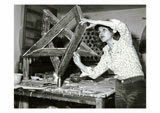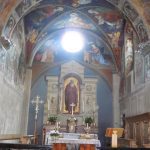 |
INFINITE POSSIBILITYMonir Shahroudy Farmanfarmaian in her studio working on Heptagon Star, Tehran, 1975 |
Presentation Examines 80 Sculptural Works and Drawings from the 1970s to the Present
Exhibition: Monir Shahroudy Farmanfarmaian: Infinite Possibility. Mirror Works and
Drawings 1974–2014
Venue: Solomon R. Guggenheim Museum, 1071 Fifth Avenue, New York
Location: Tower 2, Tower 4, Monitor 4 and Thannhauser 4 galleries
Dates: March 13–June 3, 2015
Media Preview: Wednesday, March 11, 9–11 am
(NEW YORK, NY – January 30, 2015) — From March 13 to June 3, 2015, the Solomon R.
Guggenheim Museum will present the first comprehensive exhibition in the United States of the
celebrated Iranian artist Monir Shahroudy Farmanfarmaian (b. 1924). In recognition of a lengthy career,
Monir Shahroudy Farmanfarmaian: Infinite Possibility. Mirror Works and Drawings 1974–2014 focuses on
the faceted mirror sculptures and corresponding geometric drawings Monir has produced over the past
forty years. The majority of the selected works in this exhibition are from the artist’s own collection, and
many have never been shown to the public.
Monir’s rich body of work references Persian architectural and decorative tradition, the mathematical
basis of geometric forms in Islamic pattern, and Sufi cosmology. When considered along with the
Guggenheim’s historical commitment to abstraction and internationalism, the exhibition offers a timely
opportunity to examine Monir’s rich body of work in its own right and as part of an increasingly
transnational perspective on artistic production and its reception.
Monir Shahroudy Farmanfarmaian: Infinite Possibility. Mirror Works and Drawings 1974–2014 is organized
by the Serralves Museum of Contemporary Art, Porto, Portugal, where it was on view in fall 2014
before traveling to New York. The exhibition is curated by Suzanne Cotter, Director, Serralves Museum
of Contemporary Art, Porto, and former Curator, Abu Dhabi Project, Solomon R. Guggenheim
Foundation, with assistance from Karole Vail, Associate Curator, Solomon R. Guggenheim Museum,
for its New York presentation.
The Leadership Committee for Infinite Possibility is gratefully acknowledged for its support, with special
thanks to Simin N. Allison, Maryam Eisler, The Soudavar Memorial Foundation, Mohammed Afkhami,
Patricia and Alexander Farman-Farmaian, Haines Gallery, Yasmine Nainzadeh and Sara Nainzadeh,
Nazgol and Kambiz Shahbazi, and The Third Line.
Monir Shahroudy Farmanfarmaian: Infinite Possibility. Mirror Works and Drawings 1974–2014 includes
early wood, plaster, and mirror reliefs, a series of large-scale geometric mirror sculptures, and an
impressive body of works on paper, focusing on a sculptural and graphic oeuvre developed over a
period of more than forty years. The presentation reveals how the compositional principles used by the
artist during this period were translated into large-scale commissions, including a series of etched glass
doors created for a New York townhouse in the early 1980s. A selection of previously unseen abstract
works on paper produced between 1974 and 2014 reveals the central role of drawing as a conceptual
foundation for Monir’s sculptural practice. The artist’s ambitious mirror sculptures, known as “geometric
families,” which she produced in the last decade since reinstating her studio in Tehran, will also be on
view. Monir’s prolific body of work is characterized by the merging of visual and spatial experience and a
distinctive approach to abstraction, coupled with the aesthetic tradition of Islamic architecture and
decoration, allowing for, in the artist’s own words, “infinite possibility.”
Born in Qazvin, Iran, in 1924, Monir attended the Fine Arts College of Tehran before moving to New
York in 1945, where she studied at Cornell University and at Parsons School of Design and worked as a
freelance illustrator for Vogue and as a graphic designer. These formative years in New York served as a
sort of apprenticeship for Monir, who spent time alongside fellow artists Milton Avery, Willem de
Kooning, Joan Mitchell, Louise Nevelson, Barnett Newman, and later Andy Warhol, among others.
Notably, during her time in New York, Monir visited the Guggenheim in its founding locations and was
present at the 1956 groundbreaking for the Frank Lloyd Wright–designed museum building on Fifth
Avenue. She returned to Iran in 1957 and journeyed across the country, further developing her artistic
sensibility through encounters with traditional craftsmanship. Indigenous art forms such as Turkoman
jewelry and clothing, coffee house paintings (a popular form of Iranian narrative paintings), and the
technique of reverse-glass painting influenced her work, resulting in a productive period of artistic
discovery and breakthrough that culminated in a series of commissions in Iran and exhibitions in Europe
and the United States, including presentations at Galerie Denise René in Paris and New York. The
Islamic Revolution in 1979 marked the beginning of Monir’s twenty-six-year exile in New York, during
which she focused on drawing, collage, and a few commissions, and also returned to carpet and textile
design. In 2004, when she finally returned to Iran, she reestablished her studio there and resumed
working with some of the same craftsmen she had collaborated with in the 1970s.
Monir has been the subject of solo exhibitions at the Italian Institute, Tehran (1968); Jack Kaplan
Gallery, New York (1975); the Kennedy Center, Washington, D.C. (1976); the Iran American Society,
Tehran (1976); Galerie Denise René, New York and Paris (1977); the Victoria and Albert Museum,
London (2007); and Leighton House Museum, London (2008). Her work has also been featured in a
number of group exhibitions, including the first Tehran Biennial (1958); the Venice Biennale (1958, 1964,
1966, and 2009); Gold, The Museum of Modern Art, New York (1978–79); Living Traditions:
Contemporary Art from Afghanistan, Iran, and Pakistan, Queen’s Palace, Bagh-e Babur, Kabul (2008);
The Power of Ornament, Lower Belvedere, Orangery, Vienna (2009); Asia Pacific Triennial of
Contemporary Art, Brisbane (2009–10); There is always a cup of sea to sail in, São Paulo Biennial (2010);
and Jef Guys/Monir Shahroudy Farmanfarmaian: The world as seen through a Pelican in Plexi, Wiels,
Brussels (2013).
Monir’s works are found in numerous public collections, including the Metropolitan Museum of Art,
New York; Queensland Art Gallery, Brisbane; Tate, London; and the Victoria and Albert Museum,
London. Several of the artist’s extant works from the 1970s are in the collection of the Tehran Museum
of Contemporary Art. Major commissions include installations at King Abdulaziz International Airport
in Jeddah, Saudi Arabia, Dag Hammarskjöld Tower in New York, and the Niavaran Cultural Center in
Tehran.
Education and Public Programs
Monir Shahroudy Farmanfarmaian: Infinite Possibility. Mirror Works and Drawings 1974–2014 will be
accompanied by a series of public programs, as listed below:
An Evening with Monir
Thursday, March 12, 6 pm
Following a screening of the documentary Monir (2014), the film’s subject, artist Monir Shahroudy
Farmanfarmaian is joined by artist Frank Stella and curator Suzanne Cotter for a reflection on her
practice, attitudes toward abstraction, and the artistic centers of Tehran and New York in the 1960s and
1970s. Followed by an exhibition viewing and reception. Tickets are $12, $8 members, free for students
with reservations. For more information, visit guggenheim.org/calendar.
Film Screenings: Monir
Fridays, March 20–May 29, 1 and 3 pm
Directed by Bahman Kiarostami and produced by Leyla Fakhr, the 2014 documentary Monir looks at
the life and work of Iranian artist Monir Shahroudy Farmanfarmaian, who first garnered attention in the
1970s for pioneering new forms of geometric mirror works. Providing a close-up view of a career marked
by political change in her home country and abroad, the film also traces an artistic rebirth sparked by her
return to Tehran after an absence of twenty-five years. Free with museum admission. For more
information, visit guggenheim.org/filmscreenings.
Curator’s Eye Tour
Friday, April 17, 12pm
Exhibition tour led by Karole Vail, Associate Curator.
Free with museum admission. Tour will be interpreted in ASL. For more information, visit
guggenheim.org/calendar.
Exhibition Catalogue
The exhibition is accompanied by an illustrated catalogue published by Serralves, with essays by
Suzanne Cotter; Shiva Balaghi, cultural historian of the Middle East and professor at Brown University,
Providence, Rhode Island; and Media Farzin, art historian and critic. The catalogue will be available for
purchase for $55 on guggenheim.org/store.
About the Solomon R. Guggenheim Foundation
Founded in 1937, the Solomon R. Guggenheim Foundation is dedicated to promoting the
understanding and appreciation of art, primarily of the modern and contemporary periods, through
exhibitions, education programs, research initiatives, and publications. The Guggenheim network that
began in the 1970s when the Solomon R. Guggenheim Museum, New York, was joined by the Peggy
Guggenheim Collection, Venice, has since expanded to include the Guggenheim Museum Bilbao
(opened 1997), and the Guggenheim Abu Dhabi (currently in development).The Guggenheim
Foundation continues to forge international collaborations that celebrate contemporary art,
architecture, and design within and beyond the walls of the museum, including the Guggenheim UBS
MAP Global Art Initiative and The Robert H. N. Ho Family Foundation Chinese Art Initiative. More
information about the Solomon R. Guggenheim Foundation can be found at guggenheim.org.
VISITOR INFORMATION
Admission: Adults $22, students/seniors (65+) $18, members and children under 12 free. The
Guggenheim’s free app, available with admission or by download to personal devices, offers an
enhanced visitor experience. The app features content on special exhibitions as well as access to more
than 1,600 works in the Guggenheim’s permanent collection and information about the museum’s
landmark building. Verbal Description guides for select exhibitions are also included for visitors who are
blind or have low vision. The Guggenheim app is supported by Bloomberg Philanthropies.
Museum Hours: Sun–Wed, 10 am–5:45 pm; Fri, 10 am–5:45 pm; Sat, 10 am–7:45 pm; closed Thurs. On
Saturdays, beginning at 5:45 pm, the museum hosts Pay What You Wish. For general information, call
212 423 3500 or visit the museum online at: guggenheim.org
guggenheim.org/social
Guggenheim.org/monir
#Monir


